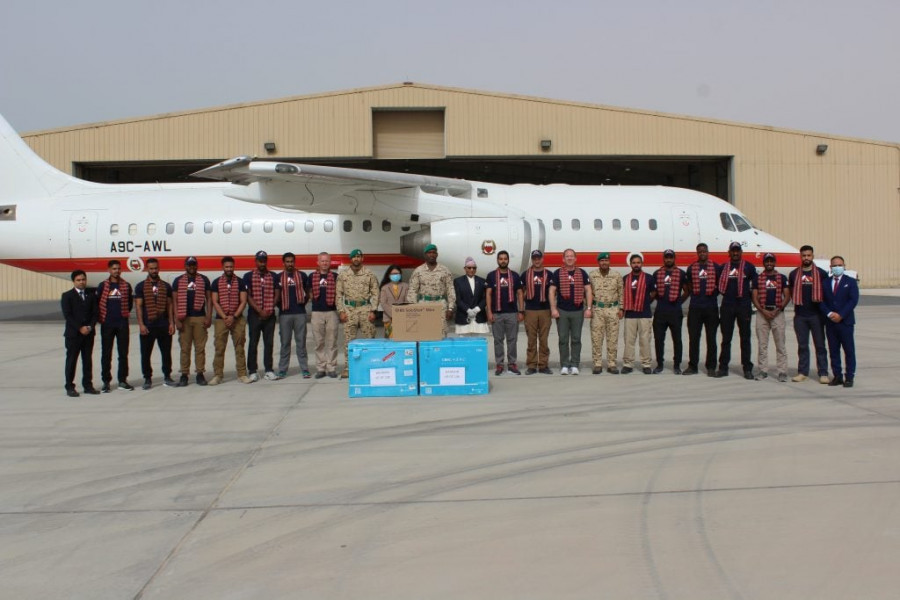Health
Vaccines flown into Nepal by Bahraini prince on Everest mission likely to be used along with China-gifted jabs
Nepal is bringing Sinopharm vaccines, the same one the member of the Bahrain royal family brought, next week. But reports suggest three doses might be needed because the Chinese shots in some cases have not generated enough protective antibodies.
Arjun Poudel
After weeks of confusion over the coronavirus vaccines, around 2,000 doses, brought to Nepal from Bahrain, the government is mulling over using them when it starts administering the jabs provided by the Chinese government under grant assistance.
Bahraini prince Mohamed Hamad Mohamed al-Khalifa and his retinue landed in Nepal on March 15 for an Everest expedition. The prince carried around 2,000 doses of coronavirus vaccine, which were said to be administered to locals of Samagaun, a village in Gorkha district.
But the Department of Drug Administration launched a probe into how the vaccines, which were said to be the AstraZeneca type, arrived in Nepal without permission. Just as the investigation was ongoing, it was found that the vaccines were from China—the BBIBP-CorV vaccine (CoronaVac) developed by Sinopharm.
Nepal has granted emergency use approval to the Sinopharm vaccine in Nepal, but not even a single dose had arrived in the country so far until it was revealed that what the Bahraini prince carried to Nepal was of that type.
China has committed to providing 800,000 Sinopharm vaccine doses to Nepal.
“The vaccines [brought from Bahrain] are with us. We will use them along with other doses provided by China,” Dr Roshan Pokhrel, chief specialist at the Health Ministry, told the Post.
Officials at the Health Ministry have said the Chinese vaccine will arrive on Monday, as the government has decided to send a plane to China on Sunday to fly them in.
The officials told the Post on Wednesday that plans are afoot to use the vaccines brought to Nepal by the Bahrain prince when they start administering the Chinese vaccines.
It, however, is not clear whether the vaccines brought by the Bahraini prince would be administered to the people of the village in Gorkha as the royal family member wished to.
“The government will decide where the doses [from Bahrain] will be used,” Pokhrel told the Post. “The vaccine can’t be provided to a particular village just because it has been chosen by the donor [prince al-Khalifa].”
The vaccines arriving from China could be a shot in the arm for Nepal which has been forced to suspend its vaccination drive, which started on January 27, after the supplies stopped.
Nepal so far has vaccinated a little over 1.7 million people and the government says it currently has around 600,000 doses in its stock.
Nepal as of now has relied on the Oxford-AstraZeneca vaccine to inoculate its population and it has been using Covishield, which is manufactured by the Serum Institute of India.
Nepal had received 1 million doses of Covishild vaccine on January 21 from India under a grant assistance, with which it launched its vaccination drive, targeting the frontline workers. A Cabinet meeting on February 16 approved an advance payment to procure 2 million doses of Covishield with the Serum Institute.
But Nepal has received just a half of the amount it has paid for. Around 348,000 doses of the AstraZeneca vaccine have been delivered to Nepal under the COVAX facility. Nepal’s plan to buy 5 million doses from the Serum Institute has been in limbo.
After conducting the second phase of the vaccination campaign, targeting people above 65 years of age, from March 7 to March 15, the drive remains halted, with no clarity when it can resume.
Officials hope that they could start the vaccination drive once they receive the 800,000 Sinopharm doses from China and the jabs from Bahrain can also be used during the campaign because they are the same type.
“We will soon decide who should be administered the Chinese vaccine,” said Pokhrel. “People with comorbidities or high-risk groups such as teachers could be the priority.”
Officials, however, might have to work hard to convince the people to take the Chinese vaccines amid reports that people might need to take even the third dose of Sinopharm, unlike in the case of the AstraZeneca vaccine which should be administered twice in a span of 8 to 12 weeks.
According to reports in The Washington Post and Wall Street Journal, the United Arab Emirates, which was among the first countries to adopt Sinopharm vaccines, the Chinese shot is not adequately generating antibody response after two doses.
Despite Nepal not having a huge vaccine hesitancy, the first phase of the immunisation drive was not as encouraging. Officials, however, were upbeat about the second phase when the elderly took the jabs easily.
While issues have emerged regarding the AstraZeneca vaccine, with reports of blood clot following the immunisation, doctors raising concern about Sinopharm vaccines could make it difficult for Nepal which has a long battle to win against the coronavirus, just as a second wave looms.
According to The Washington Post, Walid Zaher, the chief researcher for G42 Healthcare, which distributes the Sinopharm vaccine in the UAE, told Dubai Eye radio that a study was underway to give some people third doses.
G42 Healthcare is the company that coordinated Sinopharm’s Phase 3 clinical trials in the UAE and elsewhere in the Middle East.
According to the Wall Street Journal, G42 Healthcare has said a “select group of people are being administered a third shot to observe the immune system response” as part of a scientific study.
Nepali officials, however, said they will decide on administering the [Chinese] vaccines once they arrive.
The Health Ministry on Wednesday directed the Family Welfare Division to decide who should be getting the vaccines to be brought from China.
“We will hold a meeting with experts,” said Dr Samir Kumar Adhikari, joint spokesperson for the Health Ministry, “and take a decision on the priority group, accordingly.”




 8.12°C Kathmandu
8.12°C Kathmandu












%20(1).jpg&w=300&height=200)

